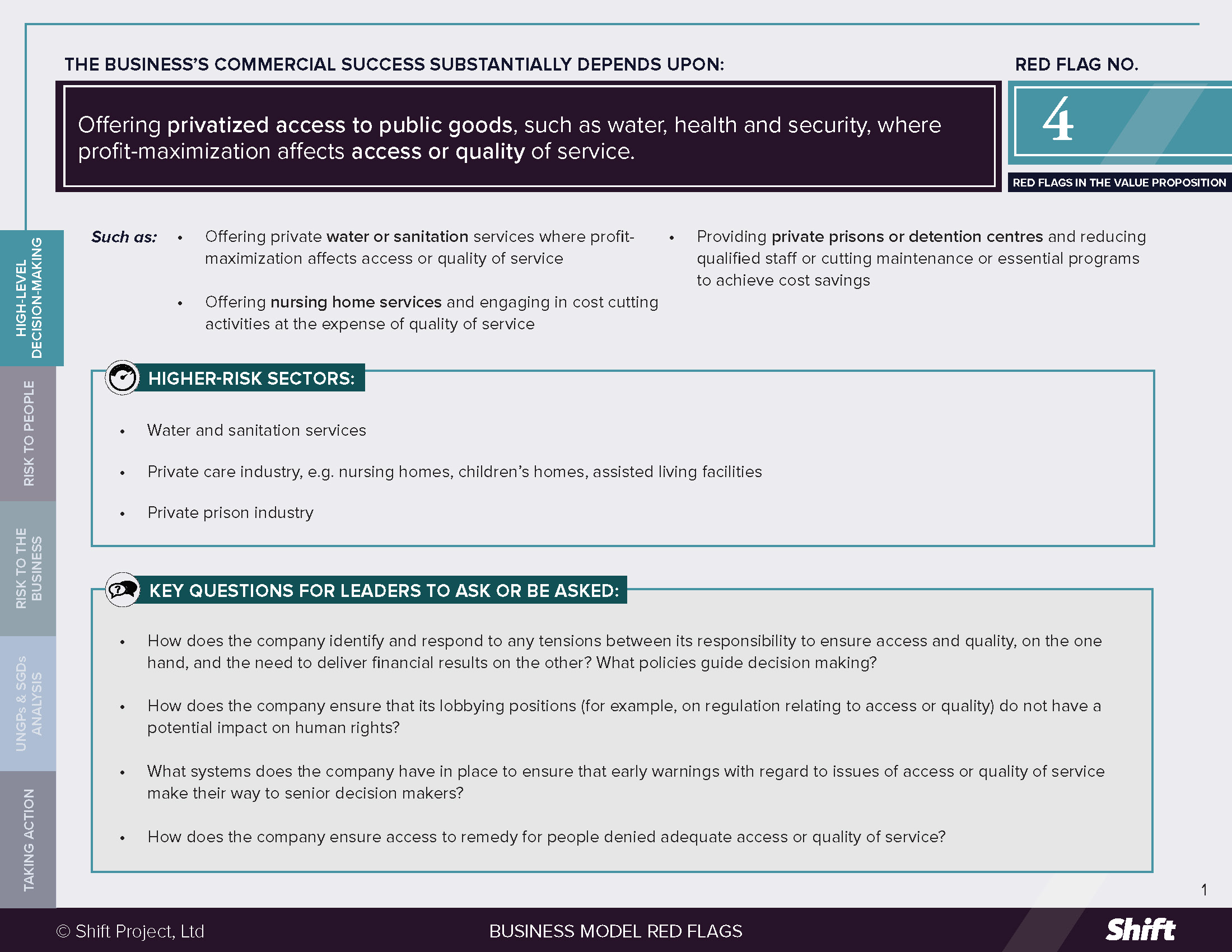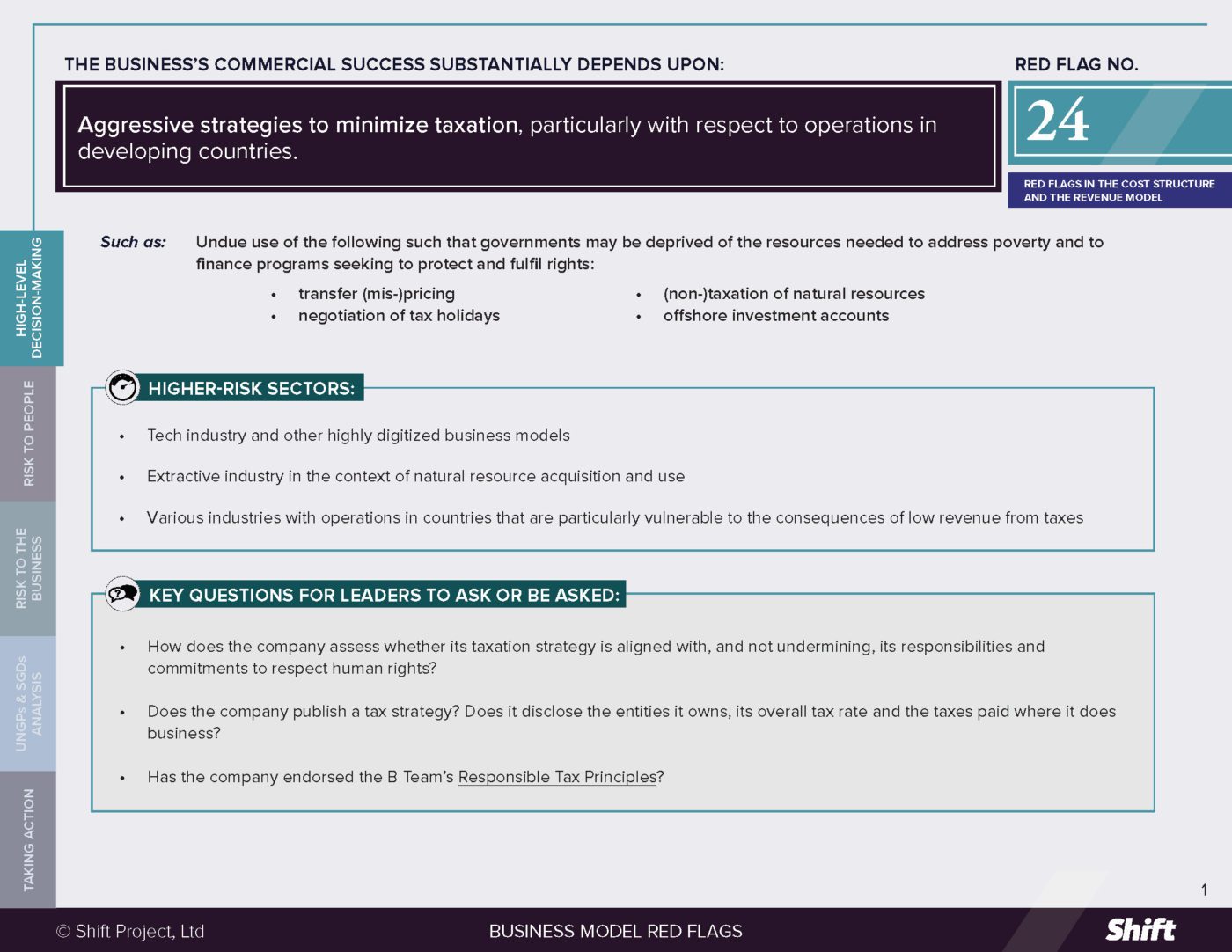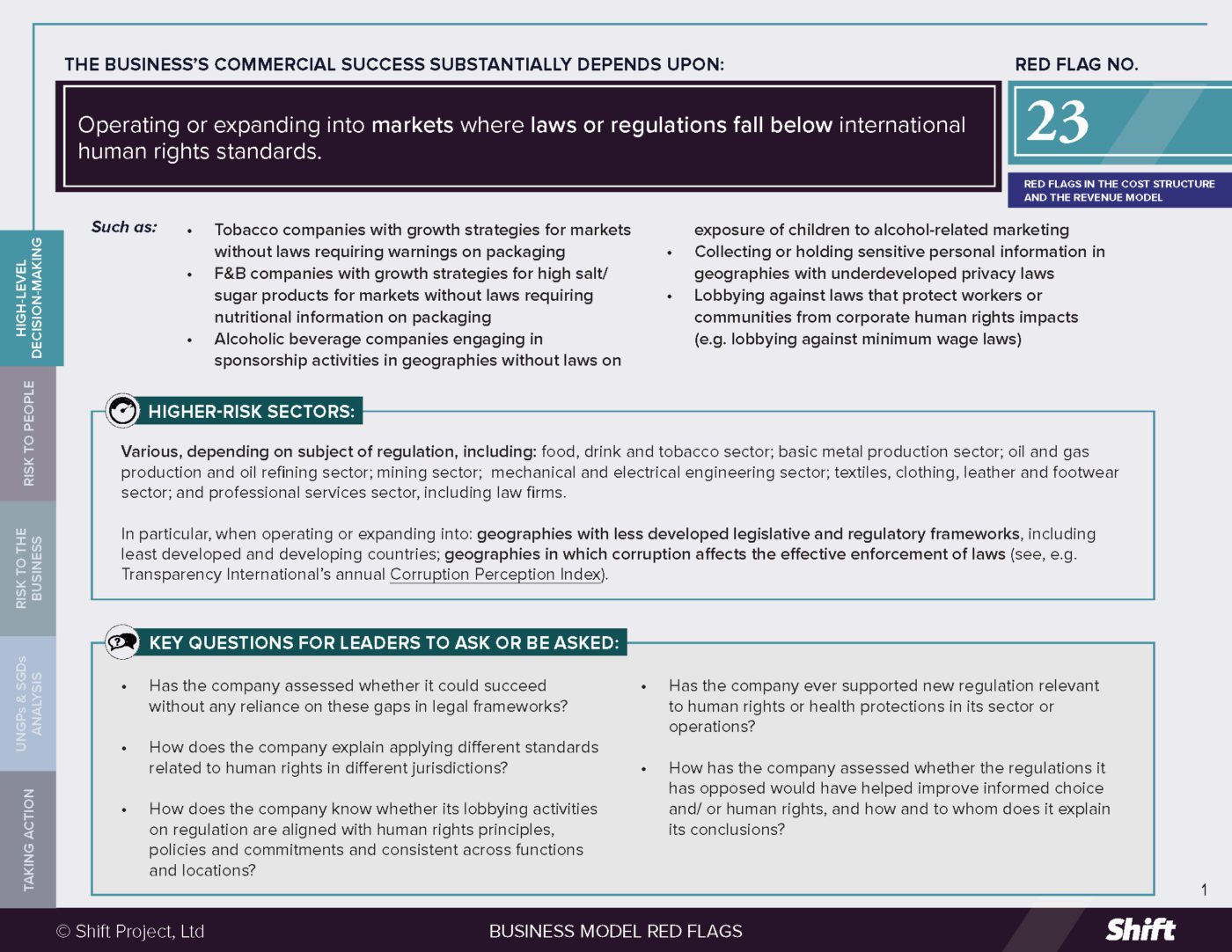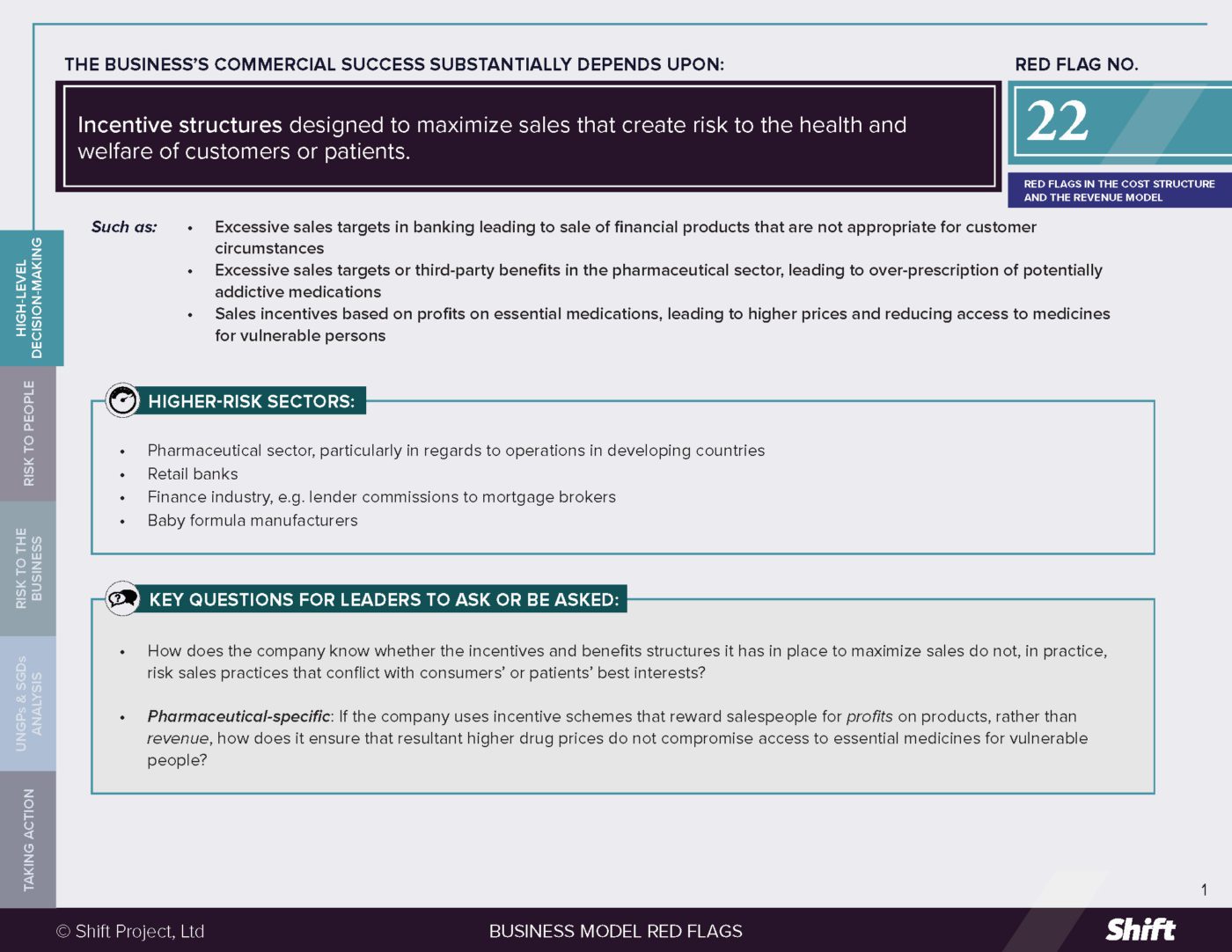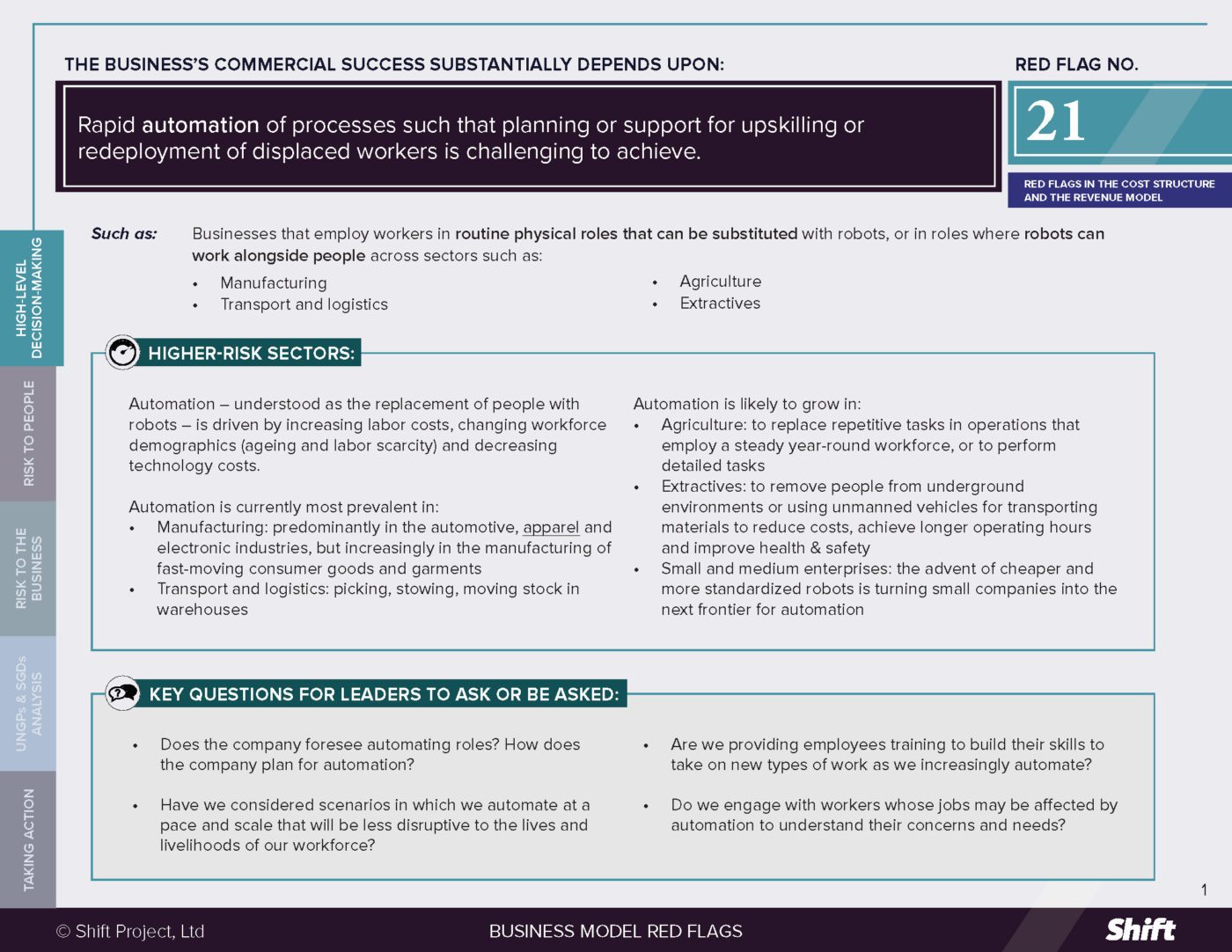RED FLAG # 4
Offering privatized access to public goods, such as water, health and security, where profit-maximization affects access or quality of service.
For Example
- Offering private water or sanitation services where profit-maximization affects access or quality of service
- Offering nursing home services and engaging in cost cutting activities at the expense of quality of service
- Providing private prisons or detention centres and reducing qualified staff or cutting maintenance or essential programs to achieve cost savings
Higher-Risk Sectors
- Water and sanitation services
- Private care industry, e.g. nursing homes, children’s homes, assisted living facilities
- Private prison industry
Questions for leaders
- How does the company identify and respond to any tensions between its responsibility to ensure access and quality, on the one hand, and the need to deliver financial results on the other? What policies guide decision making?
- How does the company ensure that its lobbying positions (for example, on regulation relating to access or quality) do not have a potential impact on human rights?
- What systems does the company have in place to ensure that early warnings with regard to issues of access or quality of service make their way to senior decision makers?
- How does the company ensure access to remedy for people denied adequate access or quality of service?
How to use this resource. ( Click on the “+” sign to expand each section. You can use the side menu to return to the full list of red flags, download this Red Flag as a PDF or share this resource. )
Understanding Risks and Opportunities
Risks to People
- Risks to people can arise where vulnerable populations require access to goods or services of adequate quality in order to realize their human rights. In such a context, decisions to reduce costs carry an increased risk of human rights impacts when compared with other goods and services.
- Human rights risks that have been highlighted in relation to private sector participation in water and sanitation include lack of equality in provision and discrimination against users (Right to non-discrimination). Further, where serious impacts to quality of service have occurred, there have been accusations that the profit motive has interfered with crucial transparency. For example, a water crisis in Flint, Michigan ”exposed residents to high levels of lead, a potent neurotoxin” and “children and infants who consumed the water are likely to suffer lifelong learning disabilities.” The Guardian reported that, according to internal company emails, the water company Veolia knew about a “problem with lead” at the time that it was “interested in securing future work with Flint.” The article notes that “Veolia disputes that its recommendations in Flint might have been colored by the prospect of future business with the city.”
- Without proper mitigation of risk, the provision of for-profit services to dependent resident populations can place vulnerable people at risk of impacts where cost-cutting leads to understaffing, insufficient staff training and oversight and pressure to streamline operational costs.
- In detention centers, reducing qualified staff, cutting maintenance and eliminating programs for detainees risks egregious living conditions, increased violence and overall neglect of prisoners’ human rights. (See Human Rights Advocates submission). (Right to security of the person; Right to adequate standard of living; Children’s rights; Right to Health). For example, private contractor G4S was the subject of a BBC exposé showing “alleged assaults, humiliation and verbal abuse of detainees by officers at [an immigration detention] centre.” Following the scandal, the company increased staffing and training, leading the chairwoman of the UK Home Affairs Select Committee to state that the subsequent reduction in profits that followed the changes “raises very serious questions about G4S’s running of the centre to make higher profits whilst not having proper staffing, training and safeguarding systems in place.”
- In residential care facilities, understaffing and insufficient provision of training can lead to unacceptable standards of hygiene; resident-to-resident aggressive behavior; restrictions on movement or social interaction; or systematic administering, without consent, of drugs to render residents more “docile” and manageable. (See Human Rights Watch report). (Right to bodily integrity (e.g. in the case of drugs administered with free, prior and informed consent); Right to health).
Risks to the Business
- Financial Risks, Especially Loss of Investment:
- Investors in a company to whom the Australian government outsourced the operation of offshore detention facilities for asylum seekers, came under pressure to divest due to allegations of inhumane conditions at the camps.
- A sustained campaign by faith-based investors and investment networks from 2017 to 2019 focused on investment in the private prison industry. The investors “raised questions about human rights abuses in the companies’ prisons that were uncovered by investigations and identified in lawsuits”, and cited “inmate deaths, poor medical care, allegations of physical and sexual abuse of detainees, and violence.” JPMorgan Chase announced in March 2019 that it “will no longer bank the private prison industry.”
- Business Opportunity and Continuity Risks: Risk of loss of government contracts, increased scrutiny and reconsideration of the social license to operate of the entire industry, potentially leading to government intervention, including renationalization or “remunicipalization” of services.
- Following the G4S immigration center scandal mentioned above, the Independent newspaper ran an article by the paper’s Chief Business Commentator with the headline “Private companies should not be doing this sort of work.” The company later announced it would end its involvement in the immigration and asylum sector but remain involved in the private prison sector.
- In 2016 following mounting criticism on conditions, the US Justice Department ended its use of private prisons. Civil society noted that the move “should prompt other federal departments and state governments” to follow suit (see Human Rights Watch).
- In 2017 the Australian government closed its main offshore immigration detention processing center on Manus Island following allegations of inhumane conditions at the center, operated by a private company.
- A “significant global trend” has been observed involving the “rejection of the private sector, due to its failures to provide adequate services” in water and sanitation, leading to renewed public ownership of those services (see UN Special Rapporteur for Special Rapporteur on the human rights to water and sanitation). Civil society has produced guides for remunicipalization of water for communities and policy makers, premised on claims that “PPPs turn out to be worse for public budgets in the long term, and lead to poor services and a loss of democratic transparency.”
What the UN Guiding Principles Say
*For an explanation of how companies can be involved in human rightsimpacts, and their related responsibilities, see here.
The UNGPs address privatization directly in Principle 5 and its commentary, noting that “States do not relinquish their international human rights law obligations when they privatize the delivery of services that may impact upon the enjoyment of human rights”. As such in the context of privatization, both the state duty to protect, and the corporate responsibility to respect, human rights are directly relevant to these types of impact.
If they fail to meet basic standards for enjoyment of rights, companies offering services upon which dependent populations rely to realize their rights, are at risk of causing a human rights impact.
The following situations are examples of situations that may give rise to an argument of contributing to impacts:
- A private company reduces services to a level that creates an environment in which violence flourishes (e.g. in a private prison);
- Aggressive pricing by the company is a factor in rendering the final price of a good or service too high for vulnerable populations to access it.
Possible Contributions to the SDGs
Providing products and services in the sectors addressed in this flag can contribute a range of SDGs, including:
SDG 6: Clean Water and Sanitation, in particular Target 6.1: By 2030, achieve universal and equitable access to safe and affordable drinking water for all, and Target 6.2: By 2030, achieve access to adequate and equitable sanitation and hygiene for all and end open defecation, paying special attention to the needs of women and girls and those in vulnerable situations.
SDG 11: Sustainable Cities and Communities, in particular Target 11.1: By 2030, ensure access for all to adequate, safe and affordable housing and basic services and upgrade slums.
SDG 16: Peace, justice and strong institutions, in particular Target 16.6: Develop effective, accountable and transparent institutions at all levels.
SDG 17: (Partnerships for the Goals) envisages partnerships between the public and private sector to be a vital part of the achievement of the SDGs. In particular, Targets 17.16 and 17.17: Public-private partnerships to be entered into in furtherance of the SDGs, and are relevant in this context to efforts to bring key services such as water and sanitation to under-served populations. However it has been noted that there is a “need to reconcile the call for increased partnerships by the SDGs, [with] the understanding that the definition of service provision should be guided by the maximization of benefits to the achievement of human rights.” (See Special Rapporteur on human rights to water and sanitation here).
Taking Action
Due Diligence Lines of Inquiry
- How is the company accessing insights into the experience of people who rely on our services, including through direct engagement with those populations?
- How does the company identify who may be particularly at risk from low or inadequate levels of service provision?
- How can both internal staff and affected individuals raise concerns through formal channels regarding service levels, without retaliation, and how does the company ensure that these are taken seriously and escalated within the company where they indicate severe risks to people.
- How are decisions about cost-cutting or changes to service provision scrutinized for their potential impacts on the rights of dependent populations, and how are independent experts brought into those processes?
Example in Focus: Nursing Care Facilities
- Do we have staffing levels adequate to provide care? Do we see a correlation between staffing levels and drug administration to patients?
- How do we ensure we obtain and document free, prior and informed consent to the administration of drugs?
- Do we limit residents’ access to judicial avenues of remedy in our contracts?
Mitigation Examples
*Mitigation examples are current or historical examples for reference, but do not offer insight into their relative maturity or effectiveness.
- In Senegal, private company Senegalaise des Eaux (SDE), a subsidiary of Saur International, has been the private partner in a public-private partnership for water management since 1996. Water supply and sanitation in Senegal is characterized by a relatively high level of access compared to the average of Sub-Saharan Africa. The company extended the service to reach low- income settlements, with social tariffs available to ensure affordability, and offers detailed customer surveys and a complaints system (see C. de Albuquerque).
- Other mitigation examples have involved action on the part of the state to maintain or reclaim control over aspects of the service provision that intersects with respect for stakeholders’ rights. For example, following accusations of abuse of detainees, the BBC reported that the UK Home Office had concluded that contracts were “no longer fit for purpose, given the lack of scope to impose financial penalties and enforce improvements in conditions and treatment” and that it had plans to include in new contracts “performance measures covering staff recruitment, induction, training, mentoring and culture” and “a contractual role for the Home Office to monitor the appropriateness of the use of force against detainees and the care of staff and detainees following an incident.”
Other Tools and Resources
Private Water and Sanitation Services:
- The Special Rapporteur on the human rights to water and sanitation will focus his 2020 report on “privatization and the human rights to water and sanitation.” See concept note and progress of public consultations here.
- Shift, Pacific Institute and UN Global Compact (2015) Guidance for Companies on Respecting the Human Rights to Water and Sanitation: Bringing a Human Rights Lens to Corporate Water Stewardship.
Private Prisons/ Detention Centers:
- Human Rights Advocates submission on Article 9 of the International Covenant on Civil and Political Rights discusses the effect of the profit motive on conditions in private prisons as a part of its “focus on what governments are required to do to avoid having detention becoming arbitrary when a person’s liberty is turned over to a private entity.”
- Human Rights Watch (2017) Code Red: The Fatal Consequences of Dangerously Substandard Medical Care in Immigration Detention a report analyzing 15 deaths in immigration detention custody in the US, concluding that “healthcare and oversight failures … present in so many of them” point to “larger, systemic deficits in immigration detention facility health care” in both publicly and privately run facilities.
Residential Care Facilities:
- Human Rights Watch (2018) “They Want Docile”: How Nursing Homes in the United States Overmedicate People with Dementia.”

 Business Model Red Flags
Business Model Red Flags  Tool for Indicator Design
Tool for Indicator Design 